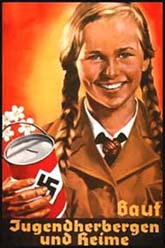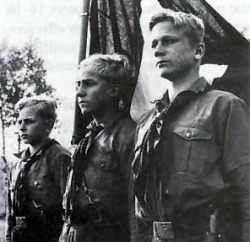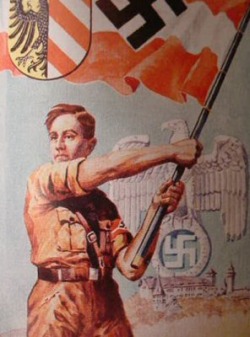Hitler Youth
Hitler Youth and the Nazi Regime
Introduction
When people think about WW2, they think about the persecution of Jews and the subjugation of the people of Europe. But most people don't think about the children of Germany. These children were the driving force behind the election of Adolf Hilter and the main force of his loyal army. These poor, brainwashed children believed in their cause, even thought they were often times only given half the truth. These fanatic children fought for their country,died for thier country, and some even dedicated their lives to showing the German people the truth, but even thought they played a major part in the war, they are often overlooked in textbooks.
Reds Verses Nazis; A Murder Victim Becomes A Martyr
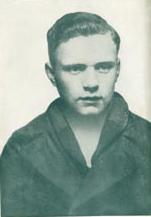
Herbert Norkus
On Sunday, January 24, 1932, a Hitler Youth member donned his brown uniform and swastika and set out on his assigned paper route. Herbert Norkus, 15, and his friend, Johannes Kirsch both belonged to the group called Hitlerjugend, or Hitler Youth, an orginization of teenagers dedicated solely to Adolf Hitler and the Nationalsozialistische Deutsche Arbeiterpartei or the National Socialist Party; aka, the Nazis.
On that fateful day Herbert and his friend, Johannes walked their assigned (as the Hitler Youth children liked to call it)"propaganda blitz" route. Herbert kept an eye out for the Communits, more commonly known and reffered to as "Reds", while Johannes dropped the flyers off at each doorstep. The two boys had worked their way around the block when Herbert spotted a Communist gang with about 40 people. Prepared to run if necessecary, the two boys moved onto the next house. Suddenly, gang surrounded them, and one of them said,"Stand still." But Johannes defiantly placed the flyer on the doorstep. He was immediately hit, Johannes stumbled, regained his footing, and dashed into an alley, while Herbert raced down the street. Herbert could not find safety anywhere he looked, and so eventually he was cornered. Upon being cornered, he was stabbed six times and still, he managed to get free and run for help. He raced to a door, and when Marie Jobs's mother opened the door, she saw a bloody hand print on the wall and a colapsed Herbert who gasped, "Help me, I've been attacked." Herbert was rushed to the emergency room at Moabit Municipal Hospital, but the help had arrived too late. Shortly after being admited, he died.
The Nazi Party became "outraged" at the "brutal" murder of Herbert Norkus who was just 15 years old, and was the youngest victim out of the 14 other Hitler Youths who had also been killed in skirmishes on the streets. Singled out, Herbert Norkus became a martyr for the Nazi cause and was given a full, elaborate, millitary funeral and for 24 hours his comrades from the Hitler Youth provided a guard of honnor. On January 27, 1932, Herbert was burried with all the proper pomp of a millitary funeral. Many hundreds of Hitler followers turned out for the funeral and formed an honor cortege that filed it's way to the New Johannes cemetary where Herbert was laid to rest.
On January 24, a national day of commemeration for all fallen Hitler Youth was declared, and a plaque was placed where Herbert had left his bloody hand print. The plaque is inscribed with, "He gave his life for Germany's freedom." During 1932, the Hitler Youth canpaigned heavily to get the Nazis elected into the Reichstag, the Parliament of Germany. On October 2, 1932, Adolf Hitler adressed 70,000 Hitler Youth children at a special rally designed for them in Potsdam, Germany. There he thanked the Hitler Youth for all their hard work, saying, ""What can happen to a people whose youth sacrifices everything in order to derve its great ideals?""(13). The children's response was to raise their hands in salute and cry out, "Heil Hitler!"
On that fateful day Herbert and his friend, Johannes walked their assigned (as the Hitler Youth children liked to call it)"propaganda blitz" route. Herbert kept an eye out for the Communits, more commonly known and reffered to as "Reds", while Johannes dropped the flyers off at each doorstep. The two boys had worked their way around the block when Herbert spotted a Communist gang with about 40 people. Prepared to run if necessecary, the two boys moved onto the next house. Suddenly, gang surrounded them, and one of them said,"Stand still." But Johannes defiantly placed the flyer on the doorstep. He was immediately hit, Johannes stumbled, regained his footing, and dashed into an alley, while Herbert raced down the street. Herbert could not find safety anywhere he looked, and so eventually he was cornered. Upon being cornered, he was stabbed six times and still, he managed to get free and run for help. He raced to a door, and when Marie Jobs's mother opened the door, she saw a bloody hand print on the wall and a colapsed Herbert who gasped, "Help me, I've been attacked." Herbert was rushed to the emergency room at Moabit Municipal Hospital, but the help had arrived too late. Shortly after being admited, he died.
The Nazi Party became "outraged" at the "brutal" murder of Herbert Norkus who was just 15 years old, and was the youngest victim out of the 14 other Hitler Youths who had also been killed in skirmishes on the streets. Singled out, Herbert Norkus became a martyr for the Nazi cause and was given a full, elaborate, millitary funeral and for 24 hours his comrades from the Hitler Youth provided a guard of honnor. On January 27, 1932, Herbert was burried with all the proper pomp of a millitary funeral. Many hundreds of Hitler followers turned out for the funeral and formed an honor cortege that filed it's way to the New Johannes cemetary where Herbert was laid to rest.
On January 24, a national day of commemeration for all fallen Hitler Youth was declared, and a plaque was placed where Herbert had left his bloody hand print. The plaque is inscribed with, "He gave his life for Germany's freedom." During 1932, the Hitler Youth canpaigned heavily to get the Nazis elected into the Reichstag, the Parliament of Germany. On October 2, 1932, Adolf Hitler adressed 70,000 Hitler Youth children at a special rally designed for them in Potsdam, Germany. There he thanked the Hitler Youth for all their hard work, saying, ""What can happen to a people whose youth sacrifices everything in order to derve its great ideals?""(13). The children's response was to raise their hands in salute and cry out, "Heil Hitler!"
Hitler's Rise to Power; the Organization of Hitler Youth

Hitler's victory parade in Berlin.
On Monday January 30, 1933, the streets of Berlin flooded with thousands of people. Earlier that day, Hitler had been made Chancellor, the second most powerful position in the country. The unemployed men of both the brown shirted S.A. (Storm Troopers), and the black shirted S.S. (Guard Squadron/ Hitler's personal body guard), carried torches and marched along with the uniformed boys and girls of Hitler Youth. The parade lasted all day long and finally ended at midnight.
As a result of WW1, poverty and unemployment had reached an all-time high in Germany by the time Hitler was in office. On February 1, Hitler adressed the German people on the radio for the first time. His voice captivated many of his listeners, ""I can remember the feeling I had when he spoke." said Sasha Schwarz, ... "At last, here's somebody who can get us out of this mess."" (19). But so many people had become apathetic about Hitler's appointment and simply found it hard to believe that his political party was any different from the rest.
Every year on April 20, Hitler's birthday, a ceremony was held where boys and girls age 10-14 were sworn into the Jungvolk (Young People), or Jungmadel (Young Madens), as a bithday present to Hitler. The ceremony was held by the Blood Banner, which was said to be dipped in the blood of all those who gave their lives for the Nazi party, including the blood of Herbert Norkus. To get accepted into the Hitler Youth, a child had to go through a rigorous process that included the initiation ceremony and getting sworn in, several tests to ensure a chid applying for Hitler Youth knew all about the Nazi political party, and many strenuous physical assesment tests. But most importantly, the appllicants had to prove they were "Aryan", Hitler's ideal race.
When the boys of Hitler Youth became 14, they advanced to Hitlerjugend and stayed there untill 18 years of age, continuing their mitileristic activities. When the girls became 14, they advanced to the B.D.M, or the Bund Deutscher Madel (Leauge of German Girls) and stayed there untill 21 years of age. When these girls became 17, they also had the option of joining the Faith and Beauty group, whose perpose was to make young women strong, beautiful, proud and self-reliant by instructing them in hygiene, dancing, and charm. In fact one of Hitler's mottos was, "... the German woman does not smoke, does not drink, and does not paint herself with makeup." (30).
On December 1, 1936, Hitler declared that all heathy young Germans (excluding Jews) must join the Hitler Youth. From now on, any German parent who refused to put their child in the Hitler Youth, would be accused of being an unloyal German, jailed, and have their child taken away from them. As a result, nearly 8 million young Germans joined Hitler Youth, and so inevitably, both private and public schools became Hitler oriented as well. On Hitler's orders, the school system fired any teacher who was Jewish or who did not agree with Nazi ideals. Therefore the German youth got a thorough education in Nazi style teachings. The school day also became much shorter, and focused on pysical sports. When the children did enter the classroom, the teachers emphasized racial teachings and conformity. No one was allowed to dissagree with or even discuss a Nazi idea.
However, to many, the new school system appealed to them. Upon reaching age twelve, if a boy had exceptional marks in his party book, he could choose to go to any one of the following schools; the Adolf Hitler School, where boys were trained in physical excercise, racial science, and loyalty to their Fuhrer or the National Poltitical Training Institute (Napola), where boys recieved additional military training, putting an emphasis on the duty, spirit, and disipline of the soldier. After graduating from either school, chosen studenents could continue their training at one of the Order Castles. Order Castles were prestigious finishing schools for only the Nazi elite. Though there were fewer in number, special B.D.M leadership schools also existed for girls. However, the purpose for all these schools remained the same; to produce good, loyal, Nazis.
As a result of WW1, poverty and unemployment had reached an all-time high in Germany by the time Hitler was in office. On February 1, Hitler adressed the German people on the radio for the first time. His voice captivated many of his listeners, ""I can remember the feeling I had when he spoke." said Sasha Schwarz, ... "At last, here's somebody who can get us out of this mess."" (19). But so many people had become apathetic about Hitler's appointment and simply found it hard to believe that his political party was any different from the rest.
Every year on April 20, Hitler's birthday, a ceremony was held where boys and girls age 10-14 were sworn into the Jungvolk (Young People), or Jungmadel (Young Madens), as a bithday present to Hitler. The ceremony was held by the Blood Banner, which was said to be dipped in the blood of all those who gave their lives for the Nazi party, including the blood of Herbert Norkus. To get accepted into the Hitler Youth, a child had to go through a rigorous process that included the initiation ceremony and getting sworn in, several tests to ensure a chid applying for Hitler Youth knew all about the Nazi political party, and many strenuous physical assesment tests. But most importantly, the appllicants had to prove they were "Aryan", Hitler's ideal race.
When the boys of Hitler Youth became 14, they advanced to Hitlerjugend and stayed there untill 18 years of age, continuing their mitileristic activities. When the girls became 14, they advanced to the B.D.M, or the Bund Deutscher Madel (Leauge of German Girls) and stayed there untill 21 years of age. When these girls became 17, they also had the option of joining the Faith and Beauty group, whose perpose was to make young women strong, beautiful, proud and self-reliant by instructing them in hygiene, dancing, and charm. In fact one of Hitler's mottos was, "... the German woman does not smoke, does not drink, and does not paint herself with makeup." (30).
On December 1, 1936, Hitler declared that all heathy young Germans (excluding Jews) must join the Hitler Youth. From now on, any German parent who refused to put their child in the Hitler Youth, would be accused of being an unloyal German, jailed, and have their child taken away from them. As a result, nearly 8 million young Germans joined Hitler Youth, and so inevitably, both private and public schools became Hitler oriented as well. On Hitler's orders, the school system fired any teacher who was Jewish or who did not agree with Nazi ideals. Therefore the German youth got a thorough education in Nazi style teachings. The school day also became much shorter, and focused on pysical sports. When the children did enter the classroom, the teachers emphasized racial teachings and conformity. No one was allowed to dissagree with or even discuss a Nazi idea.
However, to many, the new school system appealed to them. Upon reaching age twelve, if a boy had exceptional marks in his party book, he could choose to go to any one of the following schools; the Adolf Hitler School, where boys were trained in physical excercise, racial science, and loyalty to their Fuhrer or the National Poltitical Training Institute (Napola), where boys recieved additional military training, putting an emphasis on the duty, spirit, and disipline of the soldier. After graduating from either school, chosen studenents could continue their training at one of the Order Castles. Order Castles were prestigious finishing schools for only the Nazi elite. Though there were fewer in number, special B.D.M leadership schools also existed for girls. However, the purpose for all these schools remained the same; to produce good, loyal, Nazis.
The German War Machine; preparing for War
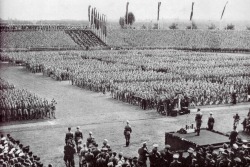
On September 5, Hitler held his last peacetime rally.
When he first began campaigning, Hitler made many promises. Among these, was one where he promised to defy the Treaty of Versailles. And he kept good on his word. In January 1937, Hitler withdrew Germany's signature from the Treaty of Versailles. Later that year he stepped up the paramilitary training of the Hitler Youth. As soon as 14 year old boys entered the Hitlerjugend (HJ), they entered specalist sections run by the Whermacht (German army), the navy, and the Luftwaffe (air force). Among the most popular specialist groups were the Flieger-HJ, the Motor-HJ, and the Marine-HJ. The Flieger-HJ was the first step to becoming a Luftwaffe pilot, and since the Germans had a shortage of aircrafts, the boys built and flew their own gliders. In the Motor-HJ, boys trained on motorcycles and learned practical skills such as trafic and car regulations as well as basic mechanical enginering know-how. And in the Marine-HJ, boys learned to navigate waterways and sail different kinds of watercrafts. There were other, smaller specailist groups too, where boys learned to signal in morse code, provide first aid and practical field medicine as well as air-raid warden training and the handling of weapons. For girls however, the options were more limited, recieving additional training only in air-raid and auxiliary nurse duties.
On Monday, September 5, 1938, Hitler held what would be the largest and last peacetime rally before the war started. In it, he praised the boys and girls of Germany for 15 minutes, triumphently telling them, ""You, my youth, never forget that one day you will rule the world!"" (77). From then on out, it was war. On September 3, 1939, Britain and France declared war on Germany, but for the Poles, it was already too late. By the time France and Britain had declared war, the Poles were already being thrown out of their homes and imprisoned in forced labor camps or sent to ghettos if they were Jews. Meanwhile, the Hitler Youth worked alongside the officers evicting the Poles and Jews from their homes and instituting German families in their stead. Not once did a Hitler Youth ask where the evicted families went, and if they did, the only things they heard were lies, ““[the SS officer] told [the Hitler Youth] that the Poles were sent to other farms or resettled in the southeastern portion of Poland.”” (79). No one even realized that there weren’t enough farms for all the relocated families to move to.
On Monday, September 5, 1938, Hitler held what would be the largest and last peacetime rally before the war started. In it, he praised the boys and girls of Germany for 15 minutes, triumphently telling them, ""You, my youth, never forget that one day you will rule the world!"" (77). From then on out, it was war. On September 3, 1939, Britain and France declared war on Germany, but for the Poles, it was already too late. By the time France and Britain had declared war, the Poles were already being thrown out of their homes and imprisoned in forced labor camps or sent to ghettos if they were Jews. Meanwhile, the Hitler Youth worked alongside the officers evicting the Poles and Jews from their homes and instituting German families in their stead. Not once did a Hitler Youth ask where the evicted families went, and if they did, the only things they heard were lies, ““[the SS officer] told [the Hitler Youth] that the Poles were sent to other farms or resettled in the southeastern portion of Poland.”” (79). No one even realized that there weren’t enough farms for all the relocated families to move to.
Hitler’s Boy Soldiers, Youth and the Resistance
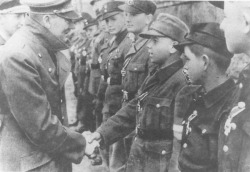
Hitler gives out Iron Cross awards to the Hitler Youth.
On May 30, 1942, British planes attacked Cologne, Germany. During the air-raid the Hitler Youth made lock down security patrols and cared for the young children in underground bunkers, they took turns operating the machines that pumped fresh air down into the bunkers and when the telephones were down, some boys acted as messengers, carrying messages from bunker to bunker. When the bombing was all done, the BDM fed and rehoused bombed out families. After the Cologne raid though, small children were sent to the country to stay in labor camps where they would be supposedly safe. Then on January 26, 1943, an order was issued that all Flakhelfner boys (Flak Helpers) older than 15 must man the antiaircraft batteries. The Flak Helpers attempted to shoot down enemy aircrafts during air-raids. The younger boys manned the searchlights. Later on in the war, boys and girls ages 13-15 manned the batteries, freeing more soldiers for frontline duty.
As German youths got more and more tired of the strict, militarist conformity of the Hitler Youth, street gangs and secret groups began to pop up. To combat these illegal groups, two different concentration camps were formed, one for girls and one for boys. In them, strict schedules were followed, starting with vigorous morning exercises and ending with solitary confinement. Hitler also began a program to euthanize all disabled people who, as he called it, were unfit to live. It was a controversial topic, but as the fear of who would be the next to die grew, the German people ultimately decided to put a stop to these killings and flooded Hitler’s office with petitions and created enough public pressure for Hitler to put an end to these killings. However, they still carried on in secret in a few hospitals even after the order was issued. It is estimated over 100,000 children and adults were killed in the program before the halt order. This program though, gave rise to the gas chambers that would later silence thousands of Jews in the concentration camps.
However, not all Germans liked Hitler and his plans for Germany. Some even took action and printed anti-Nazi leaflets, spreading the truth about what the Nazis were really doing. One such organization was the White Rose. It was headed by university students Hans Scholl and his sister, Sophie. Together they created a group that wrote and printed bold leaflets describing the plight of the Jews and other actions that the Nazis took.
But the White Rose soon came to an abrupt end, on February 18, 1943, Hans and Sophie were caught distributing leaflets in the school. Over the next few days, the Gestapo also found enough information in their apartments to arrest Christoph Probst, Willi Graf, Kurt Huber and Alexander Schmorell, who were also White Rose members. Then on February 22, 1943, four days after their arrest, the People’s Court in Munich pronounced all of them guilty. Immediately after the trial, they were lead to the execution room where the warden reported them to have all born themselves with marvelous bravery to their deaths. He said, ““They were led off, the girl first…. She went without the flicker of an eyelash. None of us understood how this could be possible. The executioner said he had never seen anyone meet his end as she did.”” (127).
Meanwhile, the Nazis were running low on soldiers. So they forcibly recruited boys by tricking them, threatening them, or they voluntarily signed up. These boy soldiers were taught everything from how to blow up an enemy tank, to camouflage techniques, to handling many different kinds of weapons. But despite the harsh training, the SS-HJ commanders showed fatherly concern for the teens; they didn’t allow smoking, drinking, or dating. Instead, the youngest recruits were given candy rather than the regular cigarette ration.
By April 1944, the SS-HJ had 20,540 boy soldiers ready to fight, and on June 6, 1944, the SS-HJ was finally activated and put into use. Commander Kurt Meyer noted the boy’s eagerness to fight and he said, ““The magnificent young grenadiers look at us with laughter in their eyes. They have no fear. They are confident. They have faith in their strength and the will to fight.”” (133). But no matter how much training the SS-HJ commanders had put into their young soldiers, they still sustained heavy tolls of up to 8,626 SS-HJ boys dead, wounded, captured or missing.
On April 20, 1945, after days of fighting in Berlin, Hitler came out to congratulate the Hitler Youth on their bravery for defending their city against the Soviets. He awarded each of them with an Iron Cross for their efforts. But on Monday, April 30, 1945, the Russians overtook the city of Berlin and Hitler committed suicide. By May 7, 1945, Germany had surrendered and the Americans took some of the boy soldiers to see what had really happed to all the Jews that had been deported to the concentration camps. But even as the Allies tried to spread the truth about Hitler, some people refused to believe it.
The Hitler Youth were never tried at the Nuremburg trials, but some were tried in more local, civilan courts, for the “de-Nazification” process to identify ardent Nazis and ban them from public office. Some even got sentences of hard labor or imprisonment. In all, more people were killed in World War 2 than in any other war in history, approximately 53 million young men in their late teens and early twenties died and millions more were crippled. In the end, Hitler’s quote about what can happen to a nation whose youth sacrifices everything, was answered in the aftermath of the war.
(Bartoletti, 2008)
As German youths got more and more tired of the strict, militarist conformity of the Hitler Youth, street gangs and secret groups began to pop up. To combat these illegal groups, two different concentration camps were formed, one for girls and one for boys. In them, strict schedules were followed, starting with vigorous morning exercises and ending with solitary confinement. Hitler also began a program to euthanize all disabled people who, as he called it, were unfit to live. It was a controversial topic, but as the fear of who would be the next to die grew, the German people ultimately decided to put a stop to these killings and flooded Hitler’s office with petitions and created enough public pressure for Hitler to put an end to these killings. However, they still carried on in secret in a few hospitals even after the order was issued. It is estimated over 100,000 children and adults were killed in the program before the halt order. This program though, gave rise to the gas chambers that would later silence thousands of Jews in the concentration camps.
However, not all Germans liked Hitler and his plans for Germany. Some even took action and printed anti-Nazi leaflets, spreading the truth about what the Nazis were really doing. One such organization was the White Rose. It was headed by university students Hans Scholl and his sister, Sophie. Together they created a group that wrote and printed bold leaflets describing the plight of the Jews and other actions that the Nazis took.
But the White Rose soon came to an abrupt end, on February 18, 1943, Hans and Sophie were caught distributing leaflets in the school. Over the next few days, the Gestapo also found enough information in their apartments to arrest Christoph Probst, Willi Graf, Kurt Huber and Alexander Schmorell, who were also White Rose members. Then on February 22, 1943, four days after their arrest, the People’s Court in Munich pronounced all of them guilty. Immediately after the trial, they were lead to the execution room where the warden reported them to have all born themselves with marvelous bravery to their deaths. He said, ““They were led off, the girl first…. She went without the flicker of an eyelash. None of us understood how this could be possible. The executioner said he had never seen anyone meet his end as she did.”” (127).
Meanwhile, the Nazis were running low on soldiers. So they forcibly recruited boys by tricking them, threatening them, or they voluntarily signed up. These boy soldiers were taught everything from how to blow up an enemy tank, to camouflage techniques, to handling many different kinds of weapons. But despite the harsh training, the SS-HJ commanders showed fatherly concern for the teens; they didn’t allow smoking, drinking, or dating. Instead, the youngest recruits were given candy rather than the regular cigarette ration.
By April 1944, the SS-HJ had 20,540 boy soldiers ready to fight, and on June 6, 1944, the SS-HJ was finally activated and put into use. Commander Kurt Meyer noted the boy’s eagerness to fight and he said, ““The magnificent young grenadiers look at us with laughter in their eyes. They have no fear. They are confident. They have faith in their strength and the will to fight.”” (133). But no matter how much training the SS-HJ commanders had put into their young soldiers, they still sustained heavy tolls of up to 8,626 SS-HJ boys dead, wounded, captured or missing.
On April 20, 1945, after days of fighting in Berlin, Hitler came out to congratulate the Hitler Youth on their bravery for defending their city against the Soviets. He awarded each of them with an Iron Cross for their efforts. But on Monday, April 30, 1945, the Russians overtook the city of Berlin and Hitler committed suicide. By May 7, 1945, Germany had surrendered and the Americans took some of the boy soldiers to see what had really happed to all the Jews that had been deported to the concentration camps. But even as the Allies tried to spread the truth about Hitler, some people refused to believe it.
The Hitler Youth were never tried at the Nuremburg trials, but some were tried in more local, civilan courts, for the “de-Nazification” process to identify ardent Nazis and ban them from public office. Some even got sentences of hard labor or imprisonment. In all, more people were killed in World War 2 than in any other war in history, approximately 53 million young men in their late teens and early twenties died and millions more were crippled. In the end, Hitler’s quote about what can happen to a nation whose youth sacrifices everything, was answered in the aftermath of the war.
(Bartoletti, 2008)
